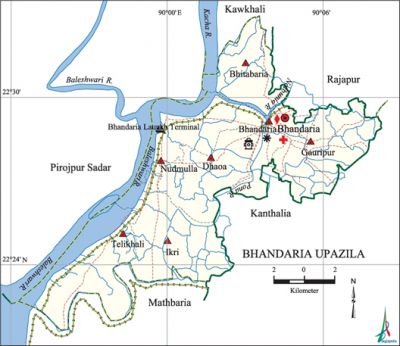Bhandaria Upazila
Bhandaria Upazila (pirojpur district) area 163.56 sq km, located in between 22°22' and 23°33' north latitudes and in between 89°54' and 90°08' east longitudes. It is bounded by rajapur and kawkhali (pirojpur) upazilas on the north, mathbaria upazila on the south, kanthalia (jhalokati) and Rajapur upazilas on the east, pirojpur sadar upazila on the west.
Population Total 148159; male 72308, female 75851; Muslim 134135, Hindu 14009 and Christian 15.
Water bodies Main rivers: Baleswari, Kacha, Pona, Nalbunia; Chaechri-Rampur Beel (Padma Baor) is also notable.
Administration Bhandaria Thana was formed in 1912 and it was turned into an upazila on 15th April 1983.
| Upazila | ||||||||
| Municipality | Union | Mouza | Village | Population | Density (per sq km) | Literacy rate (%) | ||
| Urban | Rural | Urban | Rural | |||||
| - | 7 | 37 | 45 | 25260 | 122899 | 906 | 77.2 | 65.7 |
| Upazila Town | ||||||||
|
Area |
Mouza |
Population |
Density |
Literacy rate (%) | ||||
| 9.74 | 3 | 25260 | 2593 | 77.2 | ||||
| Union | ||||
| Name of union and GO code | Area (acre) | Population | Literacy rate (%) | |
| Male | Female | |||
| Ikri 59 | 7130 | 10195 | 10875 | 63.5 |
| Gauripur 47 | 6354 | 9817 | 10591 | 73.8 |
| Telikhali 83 | 6340 | 11795 | 11907 | 56.7 |
| Dhaoa 35 | 5865 | 9435 | 10046 | 69.2 |
| Nudmulla 71 | 5003 | 10934 | 11421 | 63.2 |
| Bhandaria 11 | 2841 | 12865 | 12917 | 78.0 |
| Bhitabaria 23 | 4647 | 7267 | 8094 | 69.2 |
Source Bangladesh Population Census 2011, Bangladesh Bureau of Statistics.

Archaeological heritage and relics Dighi (tank) and twin Mosque (also known as Shia Mosque) of Bhelai Chowkider, Thakur Madan Mohan Mandir, Mazars of the martyrs of peasant rebellion (Singkhali).
Historical events Peasant rebellion was held in this upazila in 1854 at Singkhali. Peasant leaders Gagan and Mohan Miah revolted against the British rule and the local zamindars in which 17 rebels were killed.
War of Liberation The freedom fighters led by Aziz Shikder attacked the Bhandaria Police Station in August 1971 in which a number of razakars were killed. The Pak army retreated from Bhandaria Upazila after they sacked the Bhandaria Bandar on 29 November. memorial monument has been built at Shargabani.
For details: see ভাণ্ডারিয়া উপজেলা, বাংলাদেশ মুক্তিযুদ্ধ জ্ঞানকোষ (Encyclopedia of Bangladesh War of Liberation), বাংলাদেশ এশিয়াটিক সোসাইটি, ঢাকা ২০২০, খণ্ড ৭।
Religious institutions Mosque 660, temple 172. Noted religious institutions: Twin Mosque of Bhelai Chokdar, Bhandaria Jami Mosque, Ikri Jami Mosque, Tagore Madan Mohan Mandir.
Literacy rate and educational institutions Average literacy 67.7%; Male 67.6%, female 67.9%. Educational institutions: college 5, technical college 1, secondary school 41, primary school 124, madrasa 81, orphanage 3. Noted educational institutions: Bhandaria Govt. College, Majida Begum Girls College, Amanullah Higher Secondary School, Bhandaria Bihari Lal High School (1913), Bara Kanua A Majid High School (1927), Tofazzal Hossain Manik Mia High School, Bhandaria Thana High School, Ikri High School.
Newspapers and periodicals Weekly: Bhandaria Barta (1998), Mukhur Bangla (2001).
Cultural organisations Club 32, library 8, literary organisation 1, Shilpakala Academy 1.
Main sources of income Agriculture 49.82%, non-agricultural labourer 5.30%, industry 0.58%, commerce 16.44%, transport and communication 2.95%, service 11.20%, construction 1.97%, religious service' 0.35%, rent and remittance 1.46% and others 9.93%.
Ownership of agricultural land Landowner 70.05%, landless 29.95%; agricultural landowner: urban' 61.30% and rural 71.49%.
Main crops Paddy, betel leaf, chilli, sugarcane.
Extinct or nearly extinct crops Sesame, linseed, arahar, china.
Main fruits Mango, coconut, betel nut, guava, banana, Chalta, amra.
Fisheries, dairies and poultries Fishery 1850, Dairy 190, poultry 120.'
Communication facilities Pucca road 124.36 km, semi-pucca road 85 km, mud road 601 km; waterways 115 km.
Extinct or nearly extinct traditional transport Palanquin.
Noted manufactories Rice mill, saw mill, ice factory, printing press, brickfield, welding factory.
Cottage industries Blacksmith, potteries, shital pati, wood work, bamboo work, cane work.
Hats, bazars and fairs Hats and bazars are 18, fairs 4, most noted of which are Bhandaria and Ikri bazars and Dashhara, Baishakhi and Patlakhali melas.
Main exports Guava, banana, amra, betel nut, coconut, Shital Pati.
Access to electricity All the unions of the upazila are under rural electrification net-work. However 47.6% of the dwelling households have access to electricity.
Sources of drinking water Tube-well 75.7%, tap 0.5% and others 23.8%. The presence of arsenic has been detected shallow tube-well water of this upazila.
Sanitation 83.8% of dwelling households of the upazila use sanitary latrines and 15.7% of dwelling houses use non-sanitary latrines; 0.5% of households do not have latrine facilities.
Heath centres Hospital 1, satellite clinic 7, family planning centre 8.'
Natural disasters As a coastal region this upazila was affected by tidal bore and cyclone for many times. Besides, the cyclones of 1941, 1961, 1970, 1977, 1986, 1988 and 1998 caused huge loss of life and damage to settlements, crops, livestock and other properties of the upazila.
NGO activities brac, caritas, asa, CARE. [Golam Mostafa Siddiqui]
References Bangladesh Population Census 2001 and 2011, Bangladesh Bureau of Statistics; Cultural survey report of Bhandaria Upazila 2007.
